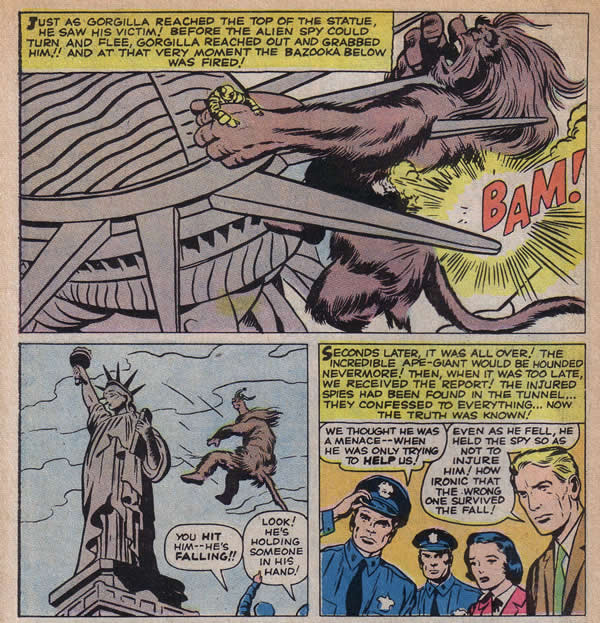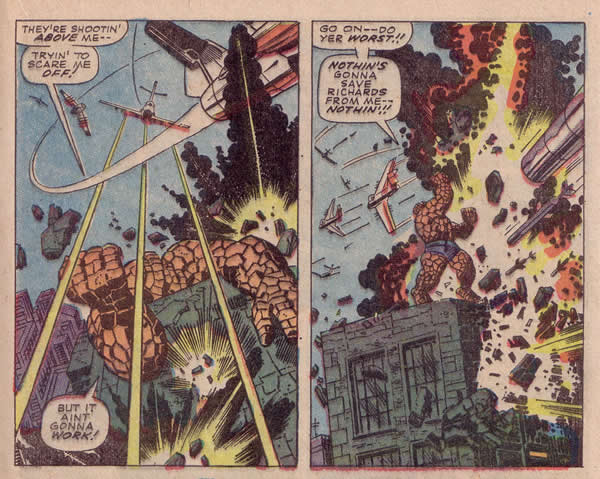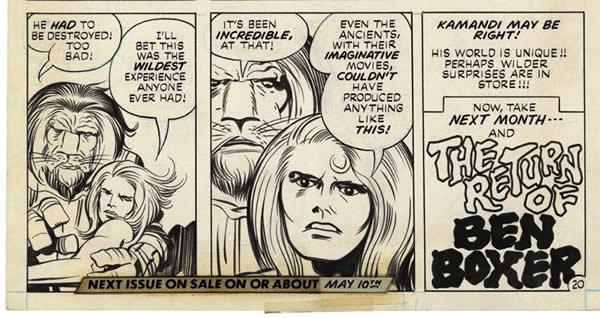Kirby has said on several occasions that he identifies with the Thing, the grumpy orange skinned monster he co-created with Stan Lee in the first issue of the Fantastic Four. The son of Austrian Jewish immigrants, Kirby grew up on the mean streets of New York’s lower east side. The area was teeming with rival street gangs, and as the artist details in his Street Code comic, he fought nearly every day to survive. Just how much anger Kirby carried inside him is difficult to tell, but he certainly channeled it into his vital and energetic artwork.
In 1933, a film appeared that must have exploded like a rush of primordial energy in the impressionable brain of the then sixteen old Kirby. The impact of King Kong is difficult to appreciate today, but suffice it to say that nothing like it had ever been seen before. The cutting edge technology of stop motion animation allowed the filmmakers to create the illusion of a gargantuan creature in a primeval lost world and then see him transported to 20th century New York City.
King Kong has been analyzed extensively, yielding interpretations running the gamut from a metaphor for the subjugation of man’s primitive instincts to that of the enslavement of African Americans. What is certain is that Kong’s treatment at the hands of a callous humanity makes him an extremely sympathetic and tragic figure and it is easy to identify with his plight.
Since over the years, Kirby has based several stories on the King Kong template, one can easily imagine that the film had a profound impact on him. When Kirby returned to Martin Goodman’s Atlas line in 1959, he and Stan Lee embarked on a series of monster stories. One of these, appearing in Tales of Suspense # 12 bears a striking resemblance to King Kong. In this story, Gorgilla, a giant jungle dwelling primate is brought to New York. Of particular interest is that in the story’s climax, Gorgilla climbs the Statue of Liberty, the symbol of America’s willingness to embrace the immigrant, in order to apprehend a villainous saboteur. He of course, like Kong tragically falls to his death.
What is even more tragic here is that like Kong, Gorgilla personifies the reviled and unfortunate immigrant, and the humans harassing him are unaware that he is acting out of feelings of warmth and protectiveness towards them. It is only when he dies that they realize Gorgilla’s altruistic motivations. Although he is perceived to be a monster, Gorgilla is human enough to be concerned for the safety of humanity.
A year or so later, when Kirby started work on the Fantastic Four, he had the ultimate misanthrope outcast hero with which to express his inner turmoil. Gradually, the Thing changes from threatening terror to loveable bear, but occasionally, his submerged rage is given outlet by nefarious characters with fiendish mind control devices. One such example is the Mad Thinker’s takeover of Ben Grimm’s brain in Fantastic Four #69. Enraged by his perceived betrayal by Reed Richards and pursued as a fugitive by the authorities, the Thing proceeds to ape Kong by climbing a high tower to do battle with a squadron of Jet fighters. When we see the Thing in this situation, we realize how much he resembles Kong, with his low forehead, prominent brow ridge and pug nose.
Kirby wasn’t finished with Kong yet. When he left Marvel for DC and his Fourth World saga was cancelled, he decided to have a bit of fun with a series called Kamandi, set in a post apocalyptic future where animals had evolved to the stage of possessing higher intelligence. In issue #7 Kirby would carry his Kong fixation to the logical extent of satire.
A teenage boy, with shoulder length blonde hair, Kamandi is pursued by a giant gorilla named Tiny, who sees him as a desirable doll sized toy. Kamandi is an obvious stand in for Anne Darrow, the woman Kong falls for in the film.
Naturally, Tiny climbs to the summit of a high tower, carrying Kamandi in his huge fist. Shot by anthropomorphic Tigers flying vintage bi-planes, Tiny falls to his doom.
[G2:21396]
Kamandi’s comment about imaginative movies is obviously meant to be ironic, which he of course doesn’t realize. In fact, such events would occur regularly on film as well as in Kirby’s fertile and derivative fantasy world. A good portion of the genius of Jack Kirby was his knack for the appropriation of popular imagery and iconography, and King Kong was something that he obviously took great pleasure in adapting.
Image 1 – Gorgilla, Stan Lee, Jack Kirby, reprint Where Creatures Roam #5
Image 2 – Fantastic Four #69 Stan Lee, Jack Kirby
Image 3 – Kamandi #7 Jack Kirby, scan courtesy of Rob Steibel
Image 4 – Kamandi #7 Jack Kirby original art scan courtesy Tom Kraft




